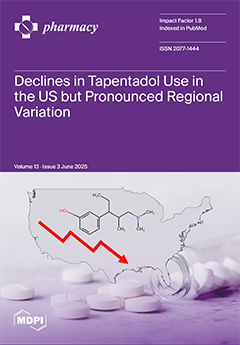Background: In intermediate care, older patients with polypharmacy are vulnerable to drug–drug interactions (DDI) and potentially inappropriate medication (PIM). Aims: To perform a consecutive intervention study to evaluate DDI/PIM.
Methods: Clinically-relevant DDI/PIM were identified using AMeLI (electronic medication list) and PRISCUS 2.0 (PIM
[...] Read more.
Background: In intermediate care, older patients with polypharmacy are vulnerable to drug–drug interactions (DDI) and potentially inappropriate medication (PIM). Aims: To perform a consecutive intervention study to evaluate DDI/PIM.
Methods: Clinically-relevant DDI/PIM were identified using AMeLI (electronic medication list) and PRISCUS 2.0 (PIM list). Consecutive patients (standard care group) were screened for DDI/PIM after admission (t0) and again before discharge (t1). In an interim period, physicians received general education about DDI/PIM. Then, consecutive patients (independent clinical pharmacy group) were screened for DDI/PIM after admission (t2). Physicians were then provided with patient-individualized recommendations by a clinical pharmacist to prevent DDI/PIM. The patients were then screened again for DDI/PIM before discharge (t3).
Results: In each group, 100 patients were included with data available for evaluation from 97 (standard care group, median age: 78 years [Q25/Q75: 69/84]) and 89 (clinical pharmacy group, 76 years [67/84]). In the standard care group, DDI were identified in 55 (57%) patients after admission (t0) and 54 (56%) before discharge (t1, ARR[t0/t1] = 0.01, NNT[t0/t1] = 100, n.s.). In the clinical pharmacy group, DDI were identified in 32 (36%) after admission (t2; ARR[t0/t2] = 0.21/NNT[t0/t2] = 5,
p < 0.01) and 26 (29%) before discharge (t3; ARR[t2/t3] = 0.07/NNT[t2/t3] = 15, n.s.; ARR[t1/t3] = 0.27/NNT[t1/t3] = 4,
p < 0.001). PIM were identified in patients at t0: 34 (35%), t1: 35 (36%, ARR[t0/t1] = −0.01/NNH[t0/t1] = 100, n.s.), t2: 25 (26%, ARR[t0/t2] = 0.09/NNT[t0/t2] = 12, n.s.), t3: 23 (24%, ARR[t2/t3] = 0.11/NNT[t2/t3] = 10, n.s.; ARR[t1/t3] = 0.12/NNT[t1/t3] = 9, n.s.).
Conclusions: In the standard care group, after admission, many DDI/PIM were identified in older intermediate care patients. Before discharge, their number was hardly influenced at all. General education for physicians led to DDI prevention after admission. In addition, the DDI frequency decreased by providing physicians with patient-individualized recommendations.
Full article





